
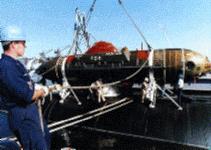
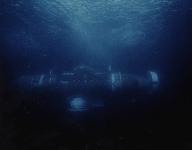
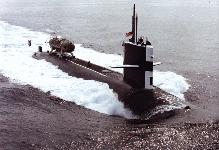
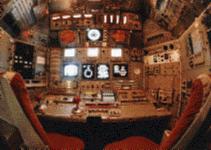
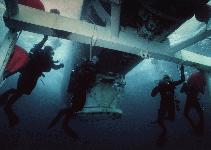
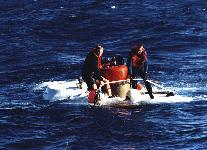



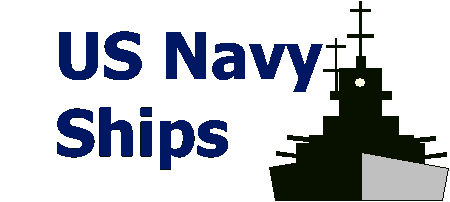
When the USS Thresher went down in the early 1960s with all hands aboard, the Navy took steps to ensure such a tragedy never occur again. Following the recommendations of a special Presidential Deep Submergence Review Group, the Deep Submergence Rescue System was developed in the mid-1960s. The deep submergence rescue vehicles Mystic (DSRV 1) and Avalon (DSRV 2) of the Deep Submergence Unit are the genesis of that program.
The DRSVs were specifically designed to fill the need for an improved means of rescuing the crew of a submarine immobilized on the ocean floor. Mystic and Avalon are the first submersibles that can be transported by land, sea and on or beneath the sea. They can operate independently of surface conditions or under ice for rapid response to an accident anywhere in the world.
The primary mission of the DSRV is to provide a quick reaction, worldwide, all�weather capability to rescue personnel from disabled submarines (DISSUB) at depths of less than 610 meters (2000 feet). The DSRV�s maximum operating depth is approximately 1524 meters (5000 feet). The DSRV can be transported by truck, aircraft, surface ship, or on a mother submarine. The DSRV can dive, locate the disabled submarine [DISSUB], and attach itself to the DISSUB�s rescue seat. After the DSRV is properly attached to the submarine, the DISSUB�s access hatches are opened and submarine personnel can enter directly into the DSRV. The DSRV then detaches itself from the submarine and transfers the rescued personnel to the support ship, which can be a specially modified submarine or a surface ship.When notified of an accident, the DSRVs, the crew and their specialized support gear can be loaded on a C-5 galaxy cargo plane at Naval Air Station North Island and flown to the nearest airport. Once it arrives, the DSRV is transported via its special land transport vehicle and taken to the staging port for rendezvous with a specially equipped mother submarine. The mother submarine then piggybacks the DSRV to the accident site to rescue the crew members. It's this versatility and economy that makes the vehicles such excellent rescue assets.
Upon notification that a submarine is submerged and disabled, the DSRV and its support equipment are transported to a port near the submarine, then loaded on a support ship. For the rest of this discussion, the DSRV support ship will be assumed to be a submarine. The mother submarine, with the DSRV mated to the after rescue/escape trunk and supported by four pylons, proceeds to the area of the DISSUB and serves as an underwater base for the DSRV. The mother submarine can launch and recover the DSRV at either the forward or after rescue/escape trunk while submerged.As the DSRV decends to the DISSUB, it uses sonar to detect the submarine�s AN/BQN�13 submarine distress pingers. The DSRV can detect the afterview of the sail of the smallest U.S. Navy submarine at about 450 meters (500 yards) under good acoustic and reverberation conditions. The DSRV can also establish and maintain voice communications with the submarine using the emergency underwater telephone. After the DSRV has located the submarine�s rescue/escape trunk and has landed on the rescue seat, the water in the DSRV mating skirt is pumped overboard or is vented to tanks on the DSRV. Depending on rescue conditions, such as depth of the submarine, underwater current, and angle of the submarine, the DSRV can use hold�down devices similar to those used by the SRC to ensure a watertight seal with the submarine.
When instructed by the DSRV, the submarine�s crew drains the upper hatch cavity, which equalizes the pressure between the DSRV and the submarine. The submarine crew then drains the trunk, if necessary. On submarines that have been modified to use the threaded eyebolt, the DSRV crew installs them, if necessary. The DSRV crew installs the hold�down devices and then removes the submarine hatch fairing. Next, the DSRV crew installs a compensating weight onto the hatch or, on SSN 21 class submarines, unscrews a spring retainer screw to make up for the removal of the fairing. On submarines with permanently welded padeyes or staples, the DSRV crew removes the submarine hatch fairing, if necessary. On earlier classes of submarines with 25�inch�diameter upper access hatches, the fairing covers are not removed. The DSRV crew then installs the hold�down devices, if necessary. The DSRV crew then installs a compensating weight, if necessary, onto the hatch or, on SSN 21 class submarines, unscrews a spring retainer screw to compensate for the removal of the fairing. The DSRV crew signals the submarine�s crew to open the upper access hatch and then the lower access hatch. The pressure in the trunk and the access compartment should be the same before the lower access hatch to the trunk is opened. The fairing plates, if removed, and supplies, as needed, are transferred to the submarine. These supplies can include oxygen, lithium hydroxide canisters, water, food, clothes, medical supplies, etc.
Submarine personnel are brought aboard the DSRV. Up to 1905 kilograms (4200 pounds) of variable ballast water can be transferred to the submarine to make up for the submarine personnel brought on board the DSRV. After the ballast and supplies are transferred, the submarine crew is directed to close the upper access hatch and the hatch cavity drain valve, the trunk flood valve, and the trunk drain valve.
One of the DSRVs is kept in rescue-ready status at all times, ready to respond to an emergency. Since their initial construction more than 25 years ago, both vehicles have undergone extensive upgrades and are widely recognized as the most sophisticated submersibles in the world. They stand ready every day of the year to support the submarine rescue needs for both the U. S. Navy and its allies world wide.
The DSRV outer hull is approximately 15 meters (50 feet) long, 2.4 meters (8 feet) in diameter, and is constructed of formed fiberglass (see Figure 594�3�1). The DSRV weighs approximately 36 metric tons (80,000 pounds). Inside the fiberglass outer hull are three interconnected spheres that form the pressure hull. Each sphere is 2.3 meters (7�1/2 feet) in diameter and is constructed of high tensile strength steel. The spheres are connected by hatches that allow personnel to move within the DSRV. The forward sphere contains the vehicle�s sophisticated control and navigation equipment and is manned by an operator and a co�operator. The center and after spheres accommodate up to 24 passengers and two DSRV crewman. Under the DSRV�s center sphere is a hemispherical skirt and shock mitigation system that allows the DSRV to mate with the rescue seat on the submarine�s rescue/escape trunk). The skirt allows a watertight seal to be made between the DSRV and the submarine. After a seal is made, the submarine�s upper access hatch can be opened and swung up into the skirt cavity. Propulsion and control of the DSRV is provided by a conventional, battery�powered, stern propeller in a movable shroud; and four ducted thrusters, two forward and two aft. The system permits the DSRV to maneuver and hover in underwater currents. The DSRV can attach to a submarine inclined to angles up to 45 degrees from vertical in either the fore and aft or athwartships direction, with an internal pressure of up to 3�1/2 atmospheres, and exposed to a current of up to 2 knots.Specifications | |
| Builder | |
| Power Plant | |
| Length | feet |
| Beam | feet |
| Draft | feet |
| Displacement | tons |
| Capacity | |
| Speed | knots ( mph) |
| Crew | |
Ships | ||||||
| Name | Number | Builder | Homeport | Ordered | Commissioned | Decommissioned |
| Mystic | DSRV 1 | |||||
| Avalon | DSRV 2 | |||||






